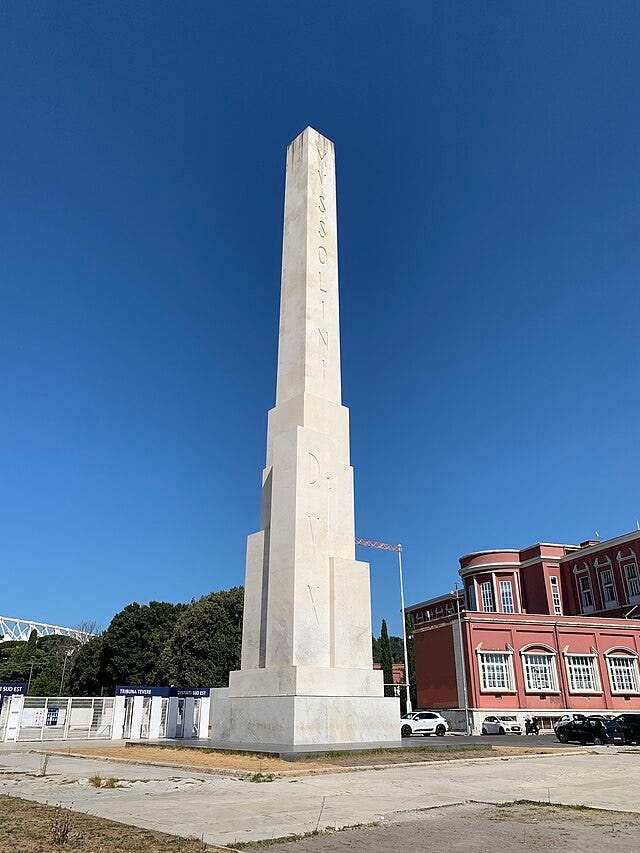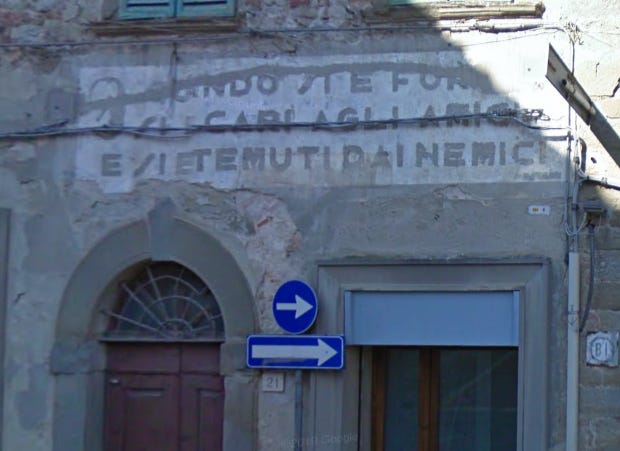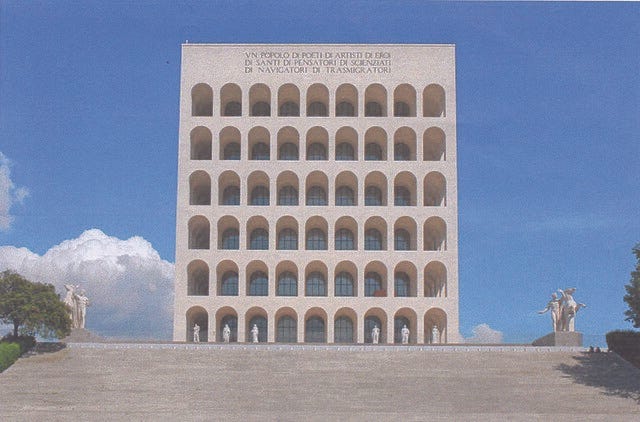The Foro Italico, on the Tiber north of the Vatican, is not in a part of the city that normally draws tourists visiting Rome. It is a sports complex which includes the Olympic Stadium and various other facilities for athletic training and competitions. It was built in the early 1930s and called the Foro Mussolini. The name changed, but it has remained intact, including the nearly 60 foot obelisk carved with the words MUSSOLINI DUX.
The column is perhaps the most visible monument from the fascist era, but is not the only one. The question of why it remains is not something I'll tackle here; such analysis is best left to serious scholars of Italian history and society. But the whole issue has always been fascinating to me.
In the ninth book in my mystery series (which I hope comes out soon), my protagonist Rick Montoya notices the faded visage of Il Duce on a wall in Lucignano, the Tuscan town where the action takes place. The town is real, of course, as is the inscription. I spotted the wall years ago on my first trip to Lucignano. Next to Mussolini are the words “When you are strong you are loved by your friends and feared by your enemies.”
I had noticed other such inscriptions in my travels around Italy, with many, like this one, on the walls of private homes. I assume that there were many more before the war, but most of them have been painted over.
When I decided to write on this topic I did some research and came across an organization in Italy that, among its activities, keeps a list of such vestiges of the fascist period in Italian history. It is the Istituto Nazionale Ferruccio Parri. Parri was an anti-fascist politician who fought with the partisans during the war and became Italy's first post-war prime minister.
On the institute's website you can find a map of “i luogi del fascismo.” https://www.luoghifascismo.it/mappa/ These “places” are mostly street names, but also include monuments, plaques, cemetery memorials, and statues. Many of the streets listed have the names of local personages who in some way contributed to the fascist cause, such as fighting in the colonial wars in Ethiopia. While local city governments made wholesale changes in the names of streets and squares after the war, often changing them to honor anti-fascist leaders like Giacomo Matteotti, apparently hundreds remain.
Perhaps the strongest and most visible reminder of the fascist period are buildings. The distinctive architecture loved by Mussolini can be found all over Italy. An entire neighborhood south of Rome, EUR, built for a planned 1942 world's fair, is pretty much all fascist architecture. You can't really tear the buildings down, so they are still in use. Perhaps the most famous structure out there is the Palazzo della Civilta' Italiana, now headquarters of the fashion house Fendi.
Because Mussolini was in power for many years, there are examples of fascist buildings all over Italy. I like to keep these substacks brief, so I will sign off now and save architecture for a separate post in the future.
As always, I remind readers that the way you can support this free Substack is to purchase one or more of my books. They are available in paperback or ebook, wherever books are sold. Here is a link for Best Served Cold, the eighth in the Rick Montoya Italian mystery series.





Very interesting as always and love the tease on your new book! Can’t wait to read it.
Hi David ~~ This installment of ‘MI’ is very interesting, and may one say indeed mysterious, as it raises more question than it answers. Without going down a rabbit hole, the photo you posted of the structure with many niches -- or arched windows -- unable to see from the photo exactly what’s going on there, reminds one of the wonderful Chanel ad, where the ‘windows’ are shuttered and one by one opened by some Mediterranean beauty emphatically shouting ‘Egoiste’ and then slamming the shutters. It spanks. Re the number of Mussolini-era structures and wall slogans still intact, I’d venture to guess that Europeans in general and Italians in particular hold a long(er) term view of history than cultures that have been around for a much shorter time and furthermore who from the younger crowd even knows the name Mussolini / Il Duce / etc, as the digital age has a very short attention span indeed. Seems they prefer to retain their ignominious remnants of history, along with the glorious and let succeeding generations be the arbiters, come what may. As always well done travelogue and looking forward to next installment.